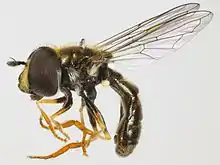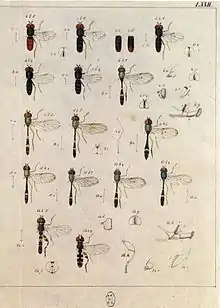Paragus haemorrhous
Paragus haemorrhous, is a widespread species of hoverfly found in many parts of Europe, Africa and the Nearctic.[1][2]
| Paragus haemorrhous | |
|---|---|
 | |
 | |
| Original figures in Meigen's Europäischen Zweiflügeligen | |
| Scientific classification | |
| Kingdom: | Animalia |
| Phylum: | Arthropoda |
| Class: | Insecta |
| Order: | Diptera |
| Family: | Syrphidae |
| Genus: | Paragus |
| Subgenus: | Pandasyophthalmus |
| Species: | P. haemorrhous |
| Binomial name | |
| Paragus haemorrhous Meigen, 1822 | |
| Synonyms | |
|
| |
Description
External images
For terms, see: Morphology of Diptera
The wing length is 3–4.5 millimetres (0.12–0.18 in). It has small black flies. Tergites have red markings. Eye pilosity is uniform. Scutellum is black. Females cannot be identified. The larva is illustrated in colour
by Rotheray (1994).[3]
See references for determination.[4][5][6][7]
Distribution
Palearctic: Fennoscandia south to Iberia and the Mediterranean basin, Israel and Turkey, Ireland eastward through Central Europe and Southern Europe (Italy, the former Yugoslavia) into European Russia. Nearctic: from the Yukon south to Costa Rica also in parts of the Afrotropical region. [8][9][10]
.JPG.webp)
Biology
Habitat: Unimproved grassland, heathland, garrigue, dune grassland, open areas and pathsides in forest up to the Larix/Pinus uncinata zone, fen meadow.[11] Flowers visited include umbellifers, Calluna, Jasione montana, Matricaria, Origanum, Polygonum, Potentilla, Solidago, Stellaria.[12] It flies May to September. The larva feeds on aphids on low herbaceous plants.
Molecular genetics
As "based on both morphological and molecular evidence", Paragus haemorrhous Meigen 1822, Paragus coadunatus (Rondani, 1847) and Paragus ascoensis Goeldlin de Tiefenau & Lucas, 1981 appear to be synonyms of Paragus tibialis (Fallén, 1817)". Rojo et al (2006).[13]
References
- Stubbs, Alan E.; Falk, Steven J (1983). British Hoverflies: An Illustrated Identification Guide (2nd ed.). London: British Entomological and Natural History Society. pp. 253, xvpp. ISBN 1-899935-03-7.
- Ball, S.G.; Morris, R.K.A. (2000). Provisional Atlas of British Hoverflies (Diptera, Syrphidae). Monks Wood, UK: Biological Record Centre. 167 pages. ISBN 1-870393-54-6.
- Rotheray G. (1993). Colour Guide to Hoverfly Larvae Diptera, Syrphidae in Britain and Europe. Dipterists Forum. pdf
- Van Veen, M. (2004). Hoverflies of Northwest Europe: identification keys to the Syrphidae. 256pp. KNNV Publishing, Utrecht.addendum.
- Van der Goot, V.S. (1981). De zweefvliegen van Noordwest - Europa en Europees Rusland, in het bijzonder van de Benelux. KNNV, Uitgave no. 32: 275pp. Amsterdam.
- Bei-Bienko, G.Y. & Steyskal, G.C. (1988). Keys to the Insects of the European Part of the USSR, Volume V: Diptera and Siphonaptera, Part I. Amerind Publishing Co., New Delhi. ISBN 81-205-0080-6.
- Coe, R.L. (1953). "Diptera: Syrphidae". Handbks. Ident. Br. Insects 10(1): 1-98. R. Ent. Soc. London. pdf.
- Fauna Europaea.
- Peck, L.V. (1988). "Syrphidae". In: Soos, A. & Papp, L. (eds.). Catalogue of Palaearctic Diptera 8: 11-230. Akad. Kiado, Budapest.
- Vockeroth, J.R. (1992). The Flower Flies of the Subfamily Syrphinae of Canada, Alaska, and Greenland (Diptera: Syrphidae). Part 18. The Insects and Arachnids of Canada. Ottawa, Ontario: Canadian Government Pub Centre. pp. 1–456. ISBN 0-660-13830-1.
- Speight, M.C.D. (2011). "Species accounts of European Syrphidae (Diptera)" (PDF). Syrph the Net, the database of European Syrphidae. 65: 285pp.
- de Buck, N. (1990) Bloembezoek en bestuivingsecologie van Zweefvliegen (Diptera, Syrphidae) in het bijzonder voor België. Doc.Trav. IRSNB, no.60, 1-167.
- Rojo, S., Ståhls, G., Pérez-Bañon, C. & Marcos-García, M.-Á. (2006) Testing molecular barcodes:invariant mitochondrial DNA sequences vs the larval and adult morphology of West Palaearctic Pandasyophthalmus species (Diptera: Syrphidae: Paragini). Eur.J.Entomol., 103: 443-458.